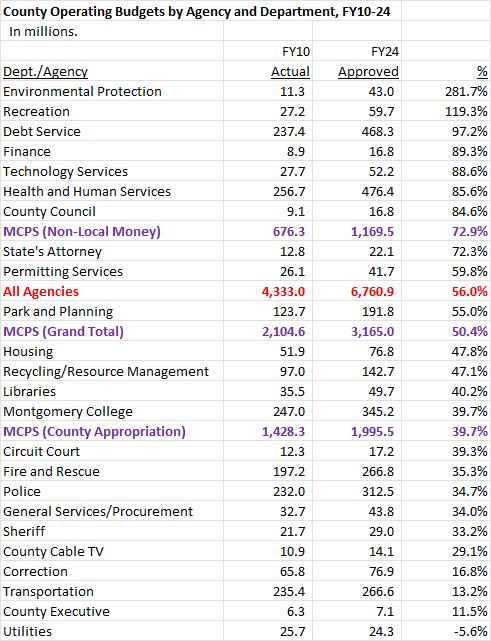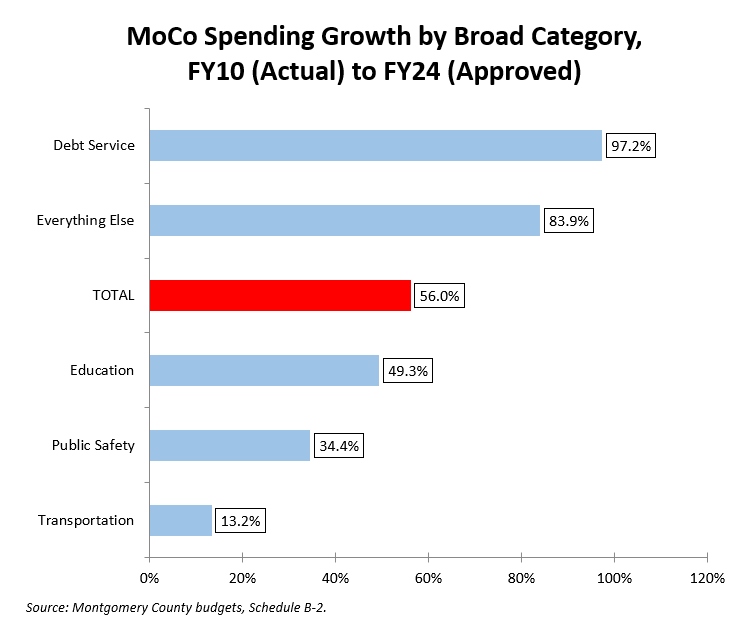By Adam Pagnucco.
Part One looked at the change in expenditures by department, agency and broad function between the FY23 and FY24 approved budgets. Part Two looked at those changes between the FY19 actual budget and the FY24 approved budget. Today, we will look at long term changes in spending.
Let’s start with the table below, which shows the change in expenditures by department and agency between the FY10 actual budget and the FY24 approved budget.

And now let’s summarize those changes with broad categories. Education is MCPS plus Montgomery College. Public safety is animal services, consumer protection, correction, emergency management, fire and rescue, police and sheriff. Transportation is the operating budgets of the Department of Transportation, the parking lot districts and Ride On and related transit. Debt service is used to finance the capital budget. Everything else is all other spending.

Let’s look first at the blocking and tackling of county government: education, public safety and transportation. While MCPS did well in FY24, its per pupil contribution from the county’s appropriations was cut three years in a row during the Great Recession and frozen for four straight years thereafter. That caused the county to rely more heavily on state aid to fund its schools. Even with recent increases, it’s unlikely that the county appropriation’s real dollar per pupil contribution will ever match its pre-Great Recession levels. The teachers union is sure to bring this up every year at budget time.
Public safety and transportation operating budgets have grown even more slowly. The county’s police department now has dire staffing shortages. The fire department has not seen long-term robust growth despite the Leggett administration’s passage of ambulance fees. These problems have started to cause stress in these departments, and among their employees.
Now to what’s growing. Debt service did not grow quickly over the last year or the last five years, but it has been a growth leader since FY10. That’s because of a large expansion in the capital budget during and after the Great Recession. In those years, interest rates were low, construction prices were restrained and the county needed economic stimulus. County Executive Ike Leggett and the county council of that time took advantage of those factors to increase the county’s construction program, which caused county debt to grow. Towards the end of Leggett’s time in office, he and the council slowed down capital budget growth, which slowed down the rise of debt service. Despite the decline in its growth, debt service remains one of the county’s largest spending categories.
Then there is everything else – all spending aside from education, public safety, transportation and debt service (capital spending). This is the true growth category in county government in both the medium term and the long term. Everything else is full of good things, like environmental protection, recreation, technology, health and human services and so on. (The appearance of county council spending as a long term growth leader will raise some eyebrows.) The question is not whether it’s good to spend money on most of these things – of course it is. Rather, the question is whether increased spending on everything else is coming at the expense of the basics – schools, cops, fire fighters and transportation facilities. When you read the press releases of county council members bragging about funding their priorities at budget time, what you see is the sheer volume of all the many things county government does. That volume grows every year.
What all of this suggests is long term mission creep – a county government that does all things for all people, limited only by the imagination of politicians. Each succeeding generation of politicians funds individual items they favor that then long outlast their tenures in office. Programs enter the budget and often never leave, and are then accompanied by new programs dreamed up by new politicians. This makes money tighter for schools, public safety and transportation. That’s not the case in every year – MCPS had a great year in FY24 – but it appears to be the case over time.
One wonders what the next 15 years have in store.
